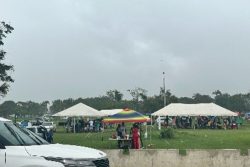If you have a pretty shirt, Alvro
Keep jamoon far, bobo
Jamoon is a stain
Don’t come out again
Even battery acid say so
 I will come back to that, but first let me say that I have always been drawn to words that capture the essence of a thing precisely, with the emphasis on “precisely”, which, by the way, is the basis for my love of our dialect: there are words there that describe things more succinctly than Standard English can.
I will come back to that, but first let me say that I have always been drawn to words that capture the essence of a thing precisely, with the emphasis on “precisely”, which, by the way, is the basis for my love of our dialect: there are words there that describe things more succinctly than Standard English can.
In that context, I have often thought, in referring to Guyanese culture, that we don’t have a precise word for that amazing and complicated combination of doing and being (sounds; smells; behaviours; beliefs; diversions; etc) that we own as Guyanese, so I have come up with the word “Guyanity” for it. Okay, “Guyananess” is a possibility, but it lacks rhythm; I love rhythm. “Guyanity” has a soca and chutney bounce; even a touch of dancehall.
If this is sounding a little frivolous, okay there’s a touch of that, but overall let me assure you I am very serious because ultimately it is my belief that our principal hope as a people, as a nation, is to concentrate on that area of our commonality, those things we all recognise intuitively as Guyanese, that go to make up our Guyanity.
Indeed, when people ask me what draws me to Guyana, and as you may suspect many do, my answer, while it is different things at different times, is always that in the midst of the various traumas of life here I am aware of this wider base below me with all these thousands of connections that I have for this place and its people. It is that cultural glue. In other words, it’s my Guyanity.
Further, from speaking to others like myself who choose to live here, it is clear, although they may not articulate it, or may express it in different ways, it is generally the same glue holding them, as well. It’s not something you can physically touch, as you can touch the skin of someone you love, but it is just as real.
The Guyanese crowd that held me on the sidewalk after a dance in Queens; that’s what they wanted to talk about. I was tired – playing in a band for 3,000 Caribbean people in a fete is exhausting; singing, believe it or not, is hard work. I was thirsty and hungry. I had a girl friend tapping her foot. I had a plane to catch in four hours. I told them that. But they wouldn’t let me go. They wanted to talk about this thing; it had them. I finally jokingly said, “Like, alyuh bed wet or wha’?” and headed off, but I knew what the impetus was – that vista of places and sounds and smells and voices and behaviours that they carried with them like a stain even as they drove the BMW in New York, or lived in the fancy house in Toronto, or went to see the Dolphins play in Miami.
Among those who live here, there are the well-set prominent folks, the ones who could be elsewhere, but a larger group numbers the more simple people like the lady living alone on a farm in the Waini, doing grinding work, she one, with a quiet joyousness that tells you, without her telling you, that she is in touch with it. Or the journalist here who contributes news items to foreign newspapers and says, “Never mind all the talk; this is the best place for me to live.” Or the coconut vendor who laughed at a comical exchange between two people on Thomas Street and said to me shaking his head, “Me ain’t wan’ live nowhere else.” He’s in touch with it.
I’m not saying that it’s something everybody discovers or accepts. Yes, it’s right under your foot bottom, but you don’t always see what’s right before you. For a lot of us, we discover it when we leave it. That’s how it was with me, and I have heard many Guyanese say the same thing.
Ultimately, it’s not a simple matter. There are many intersecting layers and aspects to it, but for many of us there comes a time when, after a long deliberation, as in my case, or in a short one, like the Thomas Street vendor, you acknowledge this thing that abides in you.
In the end, too, as in most things in life we struggle with, it’s a matter of degree. For some, for many, the pull of the Guyanity is not enough to keep us here trying to cope with the vexations. But there are others, and they are numerous too, in whom the impact of the culture triumphs and we stay the difficult course because, in the end, it’s worth it.
So what does this all have to do with jamoon? Well, I enjoy handyman work (the care you must have for crafting a song is exactly the same care you need with woodwork), and about a week ago, I was sanding a purple-heart desk top in my backyard. It’s laborious work, hours of it, and things were looking good, but I got up one morning to see that a passing bird, with some kind of belly wuk, had left three large jamoon stains, in a neat cluster, on my beautiful desk top. As you know, Mister Jamoon don’t joke. Two sanders, muscle power, belt getting hot, jamoon ain’t budging.
But two things: first of all, after I got over cussing the kiskadee, it struck me that the jamoon stain was like this Guyanity that possesses us; you can’t eradicate it, no matter where you go. And, secondly, the more I looked at the jamoon design the more I liked it, and now, honest to God, it looks like a piece of art. Serious. It looks like something from an impressionist painter that would have cost me US$10,000; the kiskadee had given me it for free.
So now I have a purple-heart desk that is a reminder of who I am and a piece of art at the same time. Who can argue with that?










